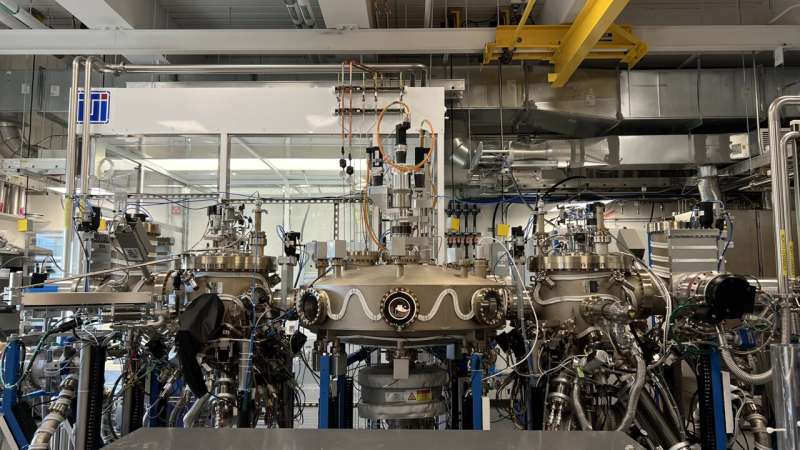February 23, 2023 feature
This article has been reviewed according to Science X's editorial process and policies. Editors have highlighted the following attributes while ensuring the content's credibility:
fact-checked
peer-reviewed publication
trusted source
proofread
Study unveils an antiferromagnetic metal phase in an electron-doped rare-earth nickelate
![(a) Electronic and magnetic phase diagram extracted from this study on films synthesized on NdGaO3 substrates. AFM and PM refer to antiferromagnetic and paramagnetic, respectively. The filled and empty symbols indicate the temperatures extracted for warming and cooling cycles, respectively, from electronic transport (◇), RXS (∘) and ARPES (□) measurements. The insets show the Fermi surfaces measured by ARPES for the AFM metallic phase and the PM metallic phase of a sample with x = 0.03. (b) Magnitude of PHE versus in-plane cooling field angle taken at 1.8 K for I // [100] (red) and I // [110] (blue). All data in this figure was taken on samples with x = 0.02–0.03. The light square points were taken with the field turned on (9 T), whereas the dark round points were taken after the removal of the field (0 T). The dashed lines serve as guides to the eye. The cartoon shows the sample geometry for I // [100]. Credit: Nature Physics (2023). DOI: 10.1038/s41567-022-01907-2 Study unveils an antiferromagnetic metal phase in an electron-doped rare-earth nickelate](https://scx1.b-cdn.net/csz/news/800a/2023/study-unveils-an-antif.jpg)
Researchers at Harvard University, the Lawrence Berkeley National Laboratory, Arizona State University, and other institutes in the United States have recently observed an antiferromagnetic metal phase in electron-doped NdNiO3 a material known to be a non-collinear antiferromagnet (i.e., exhibiting an onset of antiferromagnetic ordering that is concomitant with a transition into an insulating state).
"Previous works on the rare-earth nickelates (RNiO3) have found them to host a rather exotic phase of magnetism known as a 'noncollinear antiferromagnet,'" Qi Song, Spencer Doyle, Luca Moreschini and Julia A. Mundy, Four of the researchers who carried out the study, told Phys.org.
"This type of magnet has unique potential applications in the field of spintronics, yet rare-earth nickelates famously change spontaneously from being metallic to insulating at the exact same temperature that this noncollinear antiferromagnet phase turns on. We wanted to see if we could somehow modify one of these materials in a way so that it remained metallic, but still had this interesting magnetic phase."
Ensuring that rare-earth nickelates remain metallic at low temperatures, where their antiferromagnetic phase appears, would ultimately enable their use for the development of spintronic devices. In their experiments, Song, Doyle, Moreschini, Mundy and their colleagues tried to achieve this using the rare-earth nickelate NdNiO3.
To prompt the material to retain its antiferromagnet metal phase without eliciting its transition into an insulator, they used electron doping, a technique for changing the number of electrons in materials. Essentially, they grew a series of NdNiO3 samples in which they added varying amounts of cerium atoms in the place of neodymium atoms, to add more electrons to the system.
"Once we had these samples, we collected electrical transport measurements, where we applied a small current through each sample and measured the resistance," Doyle said. "By performing this measurement as we changed the temperature of the sample, we were able to deduce whether or not the sample was metallic or insulating in the magnetic phase."

Ultimately, to demonstrate the potential of the electron-doped antiferromagnetic metal sample they realized for the development of spintronic devices, the team also collected a further measurement, known as the "zero field planar Hall effect." Simply put, this measurement can be used to verify whether a material can "remember" whether a magnetic field had been applied to it or not, even after this field was turned off.
These tests yielded very promising results, as the electron-doped samples produced by Doyle and his colleagues demonstrated this "memory effect." Remarkably, the effect observed in these materials was very strong compared to those typically observed in antiferromagnets.
"We created a new phase in the family of nickelates, which was not seen before. The key property of these materials is that they have a metal-insulator transition, which comes together with a magnetic one, as it often happens," Moreschini explained. "Above the transition, you have weak or no magnetic order, and below you do have one, in this case, antiferromagnetism. In other previous studies, this transition had been suppressed in some conditions, but for the first time we succeeded in decoupling them: the magnetic transition is still there, but the metal-insulator transition is gone."
The electron doping-based strategy proposed by this team of researchers allowed them to elicit an antiferromagnetic metal phase in a rare-earth nickelate. Below the temperature at which the material transitions to an antiferromagnetic phase, it is still a metal, even if a less performing metal. Overall, their electron doped-samples are thus metals with an antiferromagnetic order, a phase that had not been observed before in nickelates.
In the future, the recent study by Song, Doyle, Moreschini, Mundy and their colleagues could open new and exciting possibilities for the development of spintronic devices based on rare-earth nickelates. In their next work, the team plans to explore strategies that would allow them to further increase the temperature at which the metal-metal transition of these rare-earth nickelates takes place.
"The ultimate goal of course is to push it all the way to room temperature, because that is where you want your devices to work. At the moment honestly speaking, the nickelates are still far from there, but in a broader perspective what we learned here from this new phase can hopefully guide the engineering of new phases in other families of oxides or other materials in general where these transitions happen a little closer to room temperature, and tweaking a bit the electronic correlations you can give them that last push to have them at room temperature," say the researchers.
More information: Qi Song et al, Antiferromagnetic metal phase in an electron-doped rare-earth nickelate, Nature Physics (2023). DOI: 10.1038/s41567-022-01907-2
Journal information: Nature Physics
© 2023 Science X Network





















